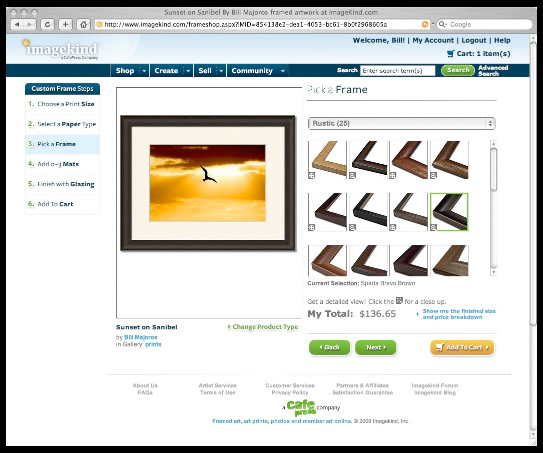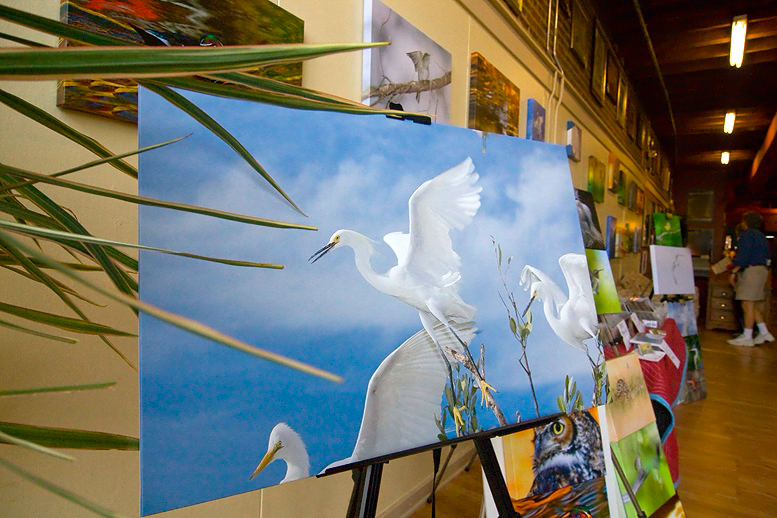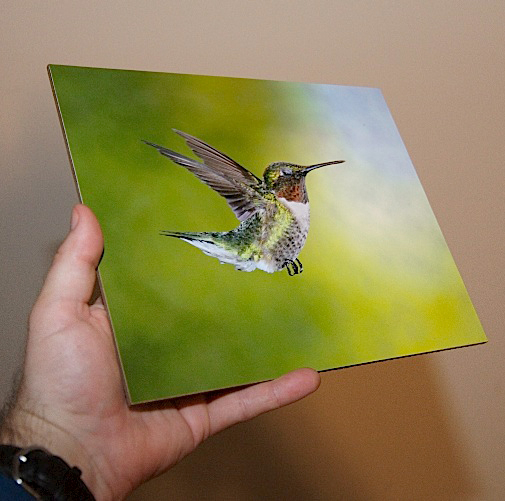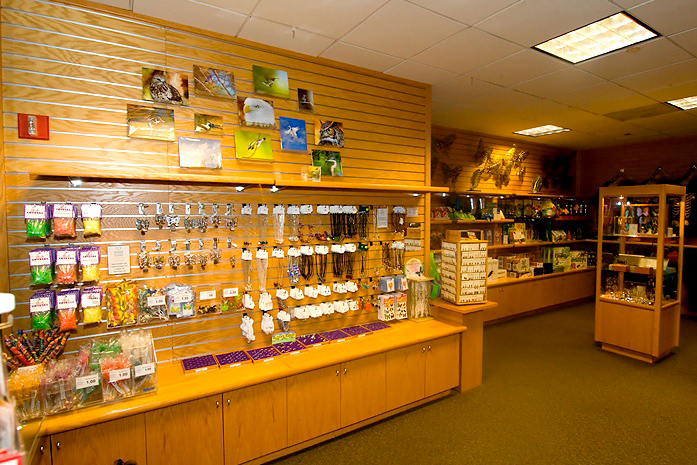|
14.4 Selling
Bird Photos
The idea of making a living by
taking and selling bird photos—i.e., spending most of your day
photographing birds and then spending a small fraction of your time
selling the photos for a considerable profit—is a wonderfully quaint
illusion that is both very attractive and potentially very difficult to
fully dispel. The problem isn’t that bird photos can’t be sold for profit, but that
doing so consistently over the long term in a financially sustainable
way seems to be the privilege of a lucky few. Certainly, the
prospect of trying to pay a mortgage and feed a growing family by
selling the occasional “lucky shot” is more than a bit terrifying.
Nevertheless, it is certainly possible to sell your
bird photos, as long as you’ve got something that somebody somewhere in
the world would really like to own. Depending on how much time
(and money) you’re willing to spend, larger or smaller numbers of sales
of your works may be correspondingly feasible. Whether this
translates into an actual profit,
after subtracting all of your costs (whether including equipment costs
or not), is another question.
For digital photos, one option with much promise is
to sell them via the internet. There are now many web sites (ImageKind, SmugMug, ArtistRising, to name just a few)
that will both host your photos and fulfill print orders from internet
customers. These businesses use a print on demand model: they don’t
actually make the physical print until they receive an order from a
customer. When the order comes in, they print the image at the
requested size, frame it, and ship it directly to the customer.

Fig. 14.4.1 : Selling photos via ImageKind is a snap. Once you’ve
uploaded high-
resolution image files, customers will be able to order prints in any
appropriate
size, with or without a frame and/or mat. They can also print
canvases. Other
companies provide similar services, though most charge the photographer
an
ongoing maintenance fee. As of this writing, ImageKind still
offers a free account
with very, very few practical limitations, and their product quality is
very good.
They handle the financial transaction (i.e., charging the customer’s
credit card) and send you a check when your earnings have exceeded some
minimum amount. I’ve never had any luck with this model, but
others have, and it’s certainly worth looking into. Note that
some outfits charge a yearly or monthly fee, so that in order to be
profitable you’d have to make at least enough to cover that cost.
More information on internet hosting sites is given in section 16.1.
A rather different approach to internet-based sales
is the so-called stock photography
option. When commercial organizations (e.g., magazines,
advertisers, book publishers) need a photo of a particular type (such
as an ocean sunset with some seagulls flying by), they typically
fulfill that need by visiting a stock photo agency and performing a
search through their archives for a suitable image. If one is
found, the requester pays a licensing fee for the use of the
image. A portion of that fee is then paid to the
photographer. Such royalty payments for individual photos can
range from a few dollars to a few hundred dollars, but are typically
very small. However, successful stock photographers with enormous
portfolios on file with a stock agency can rack up sizeable quarterly
payments if their images are used frequently enough.

Fig. 14.4.2 :
Selling your photos to stock agencies can potentially
generate significant revenue. Some of the drawbacks are that
the submission process can be frustrating, the types of photos you
take may not be in demand by an agency or its clients, and any photos
that are purchased aren’t likely to end up on anyone’s wall or to show
up in National Geographic magazine.
Submitting images to a stock agency isn’t
trivial. They tend to have very strict image quality
requirements, and the agents responsible for accepting or rejecting
submissions can be highly fickle. Also, certain types of photos,
such as those of bald eagles, are in such great supply that all of the
ongoing demand can be handled from images already aquired long ago;
thus, even the world’s most beautiful shot of a bald eagle can be
rejected by an agency simply due to their already having more eagle
shots than they need. Note that stock photography is very
different from fine-art photography:
stock photos are mostly used for illustration or for backgrounds in
advertisements (such as for beach resorts, tropical cruise lines,
realtors, etc.), not for producing wall art. A stock photo
needn’t be aesthetically pleasing all, as long as it has value as an
illustration. For photographers obsessed with capturing the
beauty of nature in aesthetically pleasing images, the idea of stock
photography can be a bit of a turn-off.
In terms of
physical (i.e., non-internet based) sales of photos, there are a number
of potential venues. Though they all have certain “barriers to entry”, some are easier to overcome than
others. One of the easier venues to get into is the art fair. Though some art
festivals are juried, meaning
that a panel of judges assesses your work before deciding whether to
allow you to participate, many are not. For the latter events,
the only barrier to entry is typically a registration fee, which I’ve
seen range from $40 to $65 (US); fees for prestigious, big-city shows
(in New York City, for example) can be higher. Obviously, for the
event to be financially worthwhile, you’d have to make enough sales to
recoup the entry fee and any other costs incurred in preparation for
the show.

Fig. 14.4.3 :
My photos on display at an art fair. Every fair is
different. This one was
spread out over several city blocks, with the art being displayed in
stores, theaters,
cafes, and dedicated galleries. Setting up your display takes a
lot of work, and then
standing there for eight hours while greeting hundreds of viewers takes
even more energy.
Even if you don’t make much money from sales, listening to people
praise your work is
gratifying in itself, and noting which photos seem most popular can be
useful later.
Note that sales precipitating from art shows can
sometimes happen days or even weeks after the show, when visitors to
your booth (who took your business card) contact you to arrange for the
purchase of a particular piece. Sometimes prospective buyers just
need more time to think about a big purchase (a $300 or $500 canvas,
for example). These are the people you most want to ensure have
your business card before they leave your booth. If you don’t yet
have a business card, it’s the first thing you should look into.
Colorful, glossy business cards with your name, email address, and the
web URL of your online gallery are extremely cheap nowadays; I get mine
from OvernightPrints.com, but
there are many other companies that can print them quickly and
inexpensively for you. Having at least several hundred of them on
hand at an art show is a good idea.

Fig. 14.4.4 :
An attractive business card may be a
greater asset than you realize. Anything that can
spark a discussion with the potential customer is
a valuable tool. Remember that buying art isn’t
like buying underwear. Customers want to know
something about you and your process; any infor-
mation you give them can increase the perceived
value of the works you’re trying to sell.
Leaving the back of the card blank
is a good idea, so that you or the customer can write notes on the back
(such as a price quote). I also recommend using your best
bird image as the background for the card (on the front of the card,
but behind the text), so that people can instantly remember where they
got the card, later when they come across it at home. Having a
striking image on the card itself can also trigger more conversation
when the customer takes note of it while standing in your booth,
keeping the customer there longer and giving him/her more time to
ponder your work. For many art collectors, the desire to own an
artist’s work is partly a function of their interest in the artist, in addition to the
aesthetic value of the work itself. Engaging the customer in
conversation about your work can help to plant you and your work into
the customer’s memory, possibly leading to sales at a later date.

Fig. 14.4.5 :
In addition to your large, framed prints or canvas wraps, it’s a good
idea to have some smaller items for sale at more modest prices.
While the number
of people willing to cough up $300 for your larger works may be
limited, the number
willing to part with $15 for an 8×10 may be much,
much higher.
In addition to large, framed prints or canvases,
it’s a good idea to have some smaller, cheaper items for sale.
There are a number of possibilities here. The simplest is to just
have some small prints on hand, preferably wrapped in a clear,
protective packaging such as those sold under the name ClearBags; you can also just buy a
large roll of clear plastic wrapping from your local art store (e.g., Michael’s) and then wrap this
around each piece and close it off with scotch tape. Since
unframed / unmatted prints are flimsy and prone to being bent or torn,
it’s best to provide some firm backing. Many people use matboard for this purpose, but I
prefer to have my prints mounted onto masonite
or styrene, because it gives
the piece more heft and makes the customer feel that they’re getting
more for their money.

Fig. 14.4.6 :
Masonite prints are both economical and practical. They’re
more durable than loose, paper prints. They feel more “solid” than
matted prints. They can easily be framed, or simply propped up on
a
table or desk as-is. When selling them, you should package them in
a clear, protective enclosure to protect the front surface from
scratches.
Another option is gatorboard,
which is an especially strong type of matboard. Some pro photo
labs can affix your photo permanently to one of these types of
substrate, for a nominal fee. Once it’s placed in a clear plastic
package, it’s relatively safe for transport by customers. I also
like to put a sticky label on the back of each of my prints, with my
name and web site address printed on it, in case the buyer later wants
to contact me about buying some more pieces. An especially nice
option is to use the extremely inexpensive gold-leaf “address” labels that you can order from
any number of online outfits. I use a company called 123print.com, which allows me to
customize the label online when placing my order.
Fig. 14.4.7 :
Gold-leaf “address” labels are an
attractive and inexpensive way to
“sign” the back of
your works and remind buyers where they can go to get more
photos from the same artist.
As mentioned previously, art fairs can require an
enormous amount of work, and can result in a disappointing number of
sales. At a recent show I netted about $95 (US), which after
subtracting the $65 registration fee left me with a $30 profit for 11
hours of work (not including prep time before the fair)—far less than “minimum wage” here in the U.S. When I
factor in the cost of the easels and other miscellaneous items
purchased specifically for the show, I ended up having spent more than
I earned. I also ended up with lots of unsold pieces which I paid
to have manufactured. Gauging the number of prints to have
manufactured for an upcoming show can be very difficult. I’ve
found the forecasts of festival organizers (in terms of the expected
number of visitors) to be rather unreliable. Public turnout can
be affected by too many variables: the weather, proximity to holidays,
the scheduling of competing events on the same day, and even the price
of gasoline.
Even if the crowds do materialize at your booth,
there’s no guarantee that they’ll buy anything—even if they absolutely
love your work. During the last show in which I displayed my
work, the overall reaction of the visitors was so emphatically positive
that I began to feel embarrassed by all the lavish praise. And
yet, if I had a dime for every person who came by and effusively
praised my photos and then walked out without buying even a $10 print,
I’d be rich enough to run for public office. Keep in mind that
different art festivals see different demographics in their
attendees. Working-class people simply don’t have the disposable
income to spend on nonessentials such as “expensive” artwork—especially during a
recession. For this reason, it may be important to know
beforehand what type of clientelle can be expected at a show before
committing yourself to participate (i.e., before sending in the entry
fee).
Note that some art shows will even demand a certain
per-sale fee; I was recently approached by an organizer of an event in
which artists were obligated to pay 15% of their proceeds—in addition
to a $40 registration fee—to the organizing entity. On top of
these fees you’ll also need to take into account any sales tax that
needs to be paid. While some artists advertise their prices as “$xxx,
plus sales tax”, it can be simpler to just
incorporate the tax into the marked price. If you then round up
to the nearest whole dollar, you don’t need to worry about carrying
around a pocketful of heavy coins.
Fig. 14.4.8 :
Don’t forget about sales tax! In many states, artists selling
their art
at art fairs are required to collect and remit sales tax for all
transactions. In order
to do so you’ll generally need to obtain a “tax ID”, which in some
districts you can
register for online. (In the U.S., your “tax ID” is sometimes
just your social security
number). Contact your state’s department of revenue for specific
guidelines. In some
cases you’ll need to formally register a business in order to obtain a
tax ID.
If there aren’t many art fairs in your neck of the
woods, you might consider setting up a booth at a flea market and
trying to sell your bird photos there. This may be an especially
promising option just prior to the holidays, when people will be on the
lookout for unique gifts. Not all flea markets are dirty,
low-class affairs: in semi-affluent neighborhoods you can sometimes
find a weekly market—such as an extended farmers’ market that includes
local arts and crafts—with booths available at reasonable rates.
Seasonal craft shows are another option worth considering; I’ve often
seen a local photographer selling matted prints at the bi-annual craft
sale held at the local botanical garden. Just keep in mind that
outdoor craft shows bring their own challenges, especially in regards
to natural elements such as rain and wind. Such shows typically
require merchants to provide their own tents and tables, which has been
a limiting factor for me (since I drive a compact car).
One venue that I particularly like is the gift shop. At a local museum
where some of my large canvases were on display for several months, the
gift shop manager agreed to stock some of my prints, and this resulted
in a number of sales. Note that gift shops are typically highly
constrained in their available display space, so they must,
understandably, assess a commission on sales of artists’
works—sometimes as much as 40%. Every gift shop is different, but
it’s worth inquiring at any such shops in your local museums, zoos,
botanical gardens, and parks, to see if any will consider selling your
prints. Though you’re unlikely to accumulate any significant
profits through these venues, by affixing a label with your name and
web site address to each item, you can use these venues to increase
your exposure and generate more traffic to your web site; if you’re set
up to sell prints over the internet, the increased traffic to your web
site may result in greater profits than direct sales at gift shops and
art shows.

Fig. 14.4.9 : A
gift shop selling my prints (upper left) at a local museum.
Seeing your
photos for sale, for the first time, in a posh gift shop is a
thrill. Profits from sales in gift
shops can be rather meager, due to the hosting shop’s commission.
Remember that gift
shops are often small, and their display space can be very precious.
Though there
are commercial art galleries that also sell photography—even nature
photography on rare occasion—I’ve had no luck with these to date
(possibly through an extreme lack of persistent effort). What
entices me about these venues is that the clientele must obviously
expect higher price tags than the flea-market crowd, giving some hope
to the thought of actually making a solid profit from the occasional
sale. What leaves me rather more hesitant is the character of the
so-called “art” I’ve seen on display in some of
these places. More generally, I’ve found city art circles to be
rather light on the inclusion of nature-themed works, so I suspect that
art shows and galleries located in cities may be a difficult sell for
the aspiring bird photographer.
Wherever you do finally decide to try selling your
avian art, there remains the issue of deciding how to price your
works. I like to think in terms of two separate product lines:
the relatively inexpensive prints priced under $50 (US), and the more
costly framed pieces or canvases starting at $100 and ranging up to
$500 or more. For the simple prints (whether loose or mounted on
masonite or matboard), since they’re intended mostly to generate
exposure and the potential for future sales of more expensive pieces, I
recommend pricing them in line with whatever other artists in your
venue are charging for similarly-sized items. I generally add a
markup of between 10% and 100% on these, depending on the venue and the
expected clientelle.
For the more expensive items, such as large, framed
prints or canvases (i.e., gallery wraps), a good rule of thumb is to
price each piece at roughly three times the manufacturing cost, and
then to adjust upward or downward depending on other factors, such as
the popularity of the piece. Based on the limited data I’ve
been able to collect so far, lowering the prices on these higher-end
items doesn’t seem to result in more sales, and indeed, the
conventional wisdom in art circles is that offering extremely low
prices is a bad idea. At a recent art fair I started out applying
a 200% markup (as per the above rule-of-thumb) and then gradually
reduced the markup over the course of the fair until I had reached 0%,
and found that the price made absolutely no difference in sales—people
lavished my photos in (undeniably genuine) praise, but refused to buy
the larger pieces at any markup level, including 0%.
|
|
|
